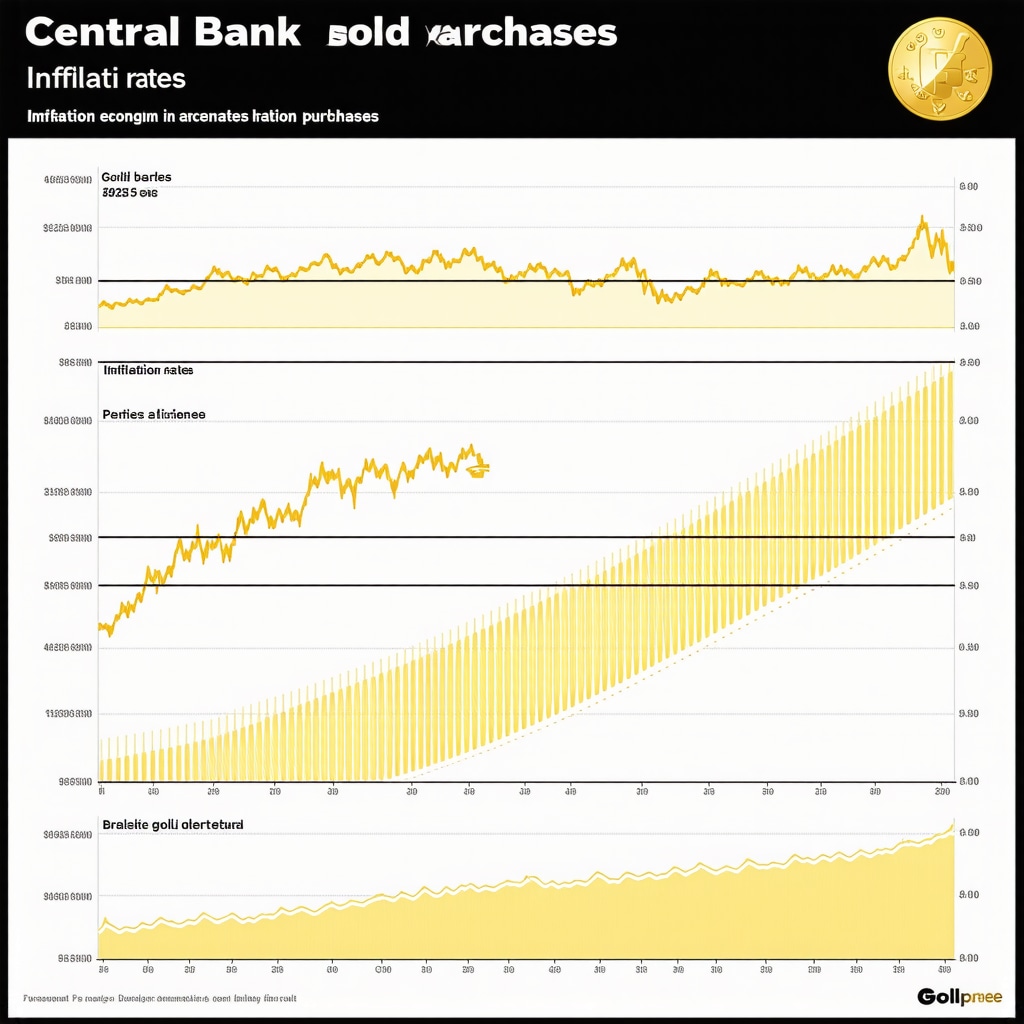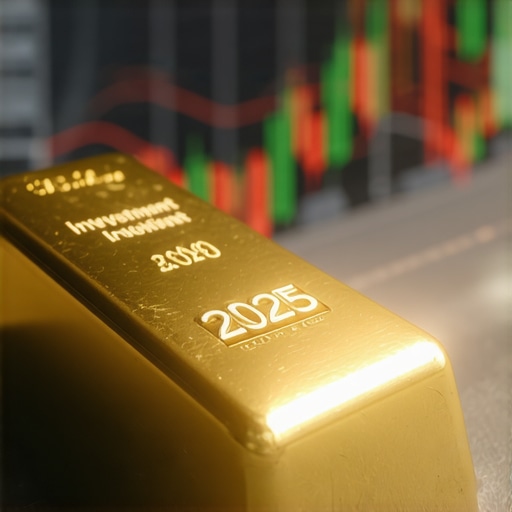Gold’s Glittering Shield: Why Investors Still Flock to the Yellow Metal
Picture this: inflation is lurking around the corner like an unwelcome party crasher, quietly eating away at the buying power of your hard-earned cash. Enter gold — the age-old refuge that has dazzled investors through centuries of economic ups and downs. But in today’s fast-evolving financial landscape, does gold still hold its legendary status as a reliable hedge against inflation? Spoiler alert: the answer is a resounding yes, but with intriguing nuances worth unpacking.
Inflation and Gold – A Timeless Tango with a Modern Twist
Historically, gold has been the go-to asset when inflation spikes, acting as a tangible store of value when paper currencies falter. Its intrinsic worth, coupled with limited supply, means that when your dollar’s purchasing power dips, gold prices often rise, cushioning portfolios from inflationary shocks. But here’s where things get interesting: not all inflationary environments are created equal, and gold’s performance can dance to different beats depending on the economic rhythm.
Is Gold Really the Inflation Hedge You Think It Is?
This rhetorical question unpacks a fascinating debate among economists and investors alike. While gold often shines brightest during high inflation, its correlation isn’t perfect or immediate. Factors like real interest rates, geopolitical tensions, and central bank policies can muddy the waters. For example, if real yields on bonds rise, gold might lose some of its luster as an inflation shield. Yet, in times of economic uncertainty or currency debasement, gold remains a stalwart safe haven.
Why Does Gold Spark So Much Investor Fervor in 2025?
Fast forward to today — with central banks around the globe tweaking policies and inflation expectations fluctuating, gold’s allure is as potent as ever. The metal’s unique ability to hedge against not just inflation but also currency volatility and geopolitical risks makes it a multifaceted tool in modern portfolios. For those curious about the latest trends and strategies, diving into effective gold investment strategies to hedge inflation in 2025 can provide a treasure trove of insights.
According to a detailed analysis by the World Gold Council, gold’s behavior during periods of rising inflation reflects its role as a store of value rather than a yield generator, underscoring its importance when traditional assets falter (source).
Gold vs. Paper Currency: Can You Trust Your Wallet?
It’s ironic — the very paper money we rely on daily is vulnerable to inflation’s stealthy erosion, while cold, hard gold maintains its shine. This paradox fuels investor interest and the perennial debate about diversifying portfolios. Curious about how to get started or refine your gold holdings? Consider exploring best practices for physical gold investments, a must-read for novices and seasoned buyers alike.
If you’re pondering whether gold truly deserves a spot in your portfolio or just want to share your own tales of inflation battles, drop a comment below. After all, every investor’s journey with gold is a story worth telling.
Unpacking Gold’s Role in a Diversified Investment Strategy
While the traditional narrative celebrates gold primarily as an inflation hedge, savvy investors recognize its broader utility. Gold’s low or even negative correlation with equities and bonds provides a valuable diversification tool, especially during market turmoil. This means that incorporating gold into a portfolio can help reduce overall volatility and improve risk-adjusted returns. Yet, the challenge lies in determining the optimal allocation — too much gold may limit growth during bullish markets, while too little may expose the portfolio to inflationary shocks.
For those looking to deepen their understanding, resources like best gold investment strategies to hedge inflation risks in 2025 offer practical guidance on balancing risk and reward effectively.
Central Bank Gold Purchases: The Quiet Force Behind Market Dynamics
Perhaps one of the less discussed yet profoundly influential factors shaping gold prices today is the strategic accumulation of gold reserves by central banks worldwide. These purchases act as a vote of confidence in gold’s enduring value and often signal broader economic or geopolitical concerns. When central banks increase their gold holdings, it can tighten supply and catalyze price appreciation, impacting investor sentiment globally.
Understanding this dynamic is crucial for investors seeking to anticipate market trends. An insightful analysis can be found in gold market analysis on central bank purchases driving prices up, which delves into the mechanisms and implications of this trend.
Could Central Bank Gold Accumulation Signal a New Era of Market Volatility?
This question invites investors to consider whether the recent surge in gold buying by central banks might presage heightened market volatility or a shift in global economic power balances. Central banks’ motivations are often tied to concerns over currency stability, inflation control, and geopolitical uncertainties. If this trend continues, gold may not only protect against inflation but also become a barometer for geopolitical risk and economic realignment.
Financial experts from the World Gold Council highlight that central bank gold demand has reached levels not seen in decades, underscoring gold’s strategic importance beyond mere investment returns (source). This evolving landscape challenges investors to stay vigilant and adaptive.
Practical Tips for Gold Investors Navigating 2025’s Complex Landscape
In this multifaceted environment, investors must adopt nuanced strategies. Diversifying across physical gold, ETFs, and mining stocks can balance liquidity, growth potential, and security. It’s also critical to monitor geopolitical developments and central bank policies that can swiftly alter gold’s trajectory.
For newcomers and veterans alike, exploring best practices for physical gold investments ensures that purchases are secure and cost-effective, avoiding common pitfalls.
Have you adjusted your gold investment strategy in light of central bank activities or inflation trends? Share your insights or questions below — your perspective enriches the community’s collective wisdom.
Decoding Gold’s Strategic Role Amid Central Bank Reserve Policies
Beyond the visible market fluctuations and price charts, a subtler narrative unfolds in the corridors of global central banks. These institutions, guardians of national economic stability, are quietly recalibrating their reserve portfolios with increasing gold allocations. This shift is not merely a reaction to inflation fears but a calculated maneuver to hedge against systemic risks such as currency devaluation, geopolitical tensions, and potential disruptions in global trade flows.
Central banks’ gold purchases serve as a powerful signal to markets and investors alike, reinforcing gold’s role as a strategic asset rather than a speculative commodity. The implication is profound: as fiat currencies face mounting pressures from expansive monetary policies and growing debt burdens, gold emerges as a financial anchor, offering a non-correlated store of value that can stabilize balance sheets under duress.
How Do Central Bank Gold Accumulation Patterns Influence Private Investor Strategies?
Understanding the interplay between central bank buying and private investor behavior requires a nuanced analysis. Central banks often acquire gold in large, discreet tranches, affecting supply dynamics and price discovery in ways not immediately perceptible to retail investors. These acquisitions can tighten physical gold availability, thereby elevating premiums on bullion and coins, while also fostering bullish sentiment in gold-related equities.
For sophisticated investors, integrating insights from central bank trends involves monitoring official reports, such as the World Gold Council’s quarterly data, alongside geopolitical developments that drive these reserve changes. Aligning portfolio allocations to anticipate these shifts can enhance risk-adjusted returns and protect against sudden market dislocations.
Moreover, considering gold mining stocks and ETFs in tandem with physical holdings can provide layered exposure, balancing liquidity and growth potential in volatile markets.
Leveraging Gold’s Portfolio Diversification Power in an Era of Rising Inflation
While gold’s role as an inflation hedge remains well documented, its true value extends into complex portfolio construction strategies, especially in the current economic climate characterized by persistent inflationary pressures and erratic monetary policy signals. Beyond simply holding gold as a standalone asset, investors are increasingly employing tactical allocation approaches, dynamically adjusting gold exposure based on inflation expectations, interest rate trajectories, and real yield environments.
For instance, during periods when real interest rates turn negative, gold tends to outperform as the opportunity cost of holding non-yielding assets diminishes. Conversely, when central banks signal tightening measures, gold’s relative appeal may soften, prompting investors to recalibrate their holdings. This dynamic interplay demands active portfolio management and deep market intelligence.
In practice, deploying a diversified gold strategy might involve combining physical bullion for long-term preservation, gold-backed ETFs for liquidity, and selective mining equities to tap into operational leverage on rising gold prices. This multi-faceted approach optimizes the risk-return profile while maintaining resilience against inflation shocks.
What Are the Risks and Mitigation Strategies for Gold Investors Amid Central Bank Activity and Inflation Volatility?
While gold offers compelling benefits, investors must remain cognizant of inherent risks. Price volatility driven by speculative flows, sudden shifts in monetary policy, or changes in global economic sentiment can lead to sharp corrections. Additionally, geopolitical developments that impact supply chains or mining operations introduce operational risks for mining equities.
Mitigating these risks involves diversification across asset types and geographies, vigilant monitoring of macroeconomic indicators, and employing hedging strategies where appropriate. For example, options and futures contracts can provide downside protection, while staggered acquisition of physical gold can smooth entry price risk.
Consulting authoritative sources such as the World Gold Council’s Central Bank Gold Demand report offers critical insights into supply-demand fundamentals and market sentiment, empowering investors to make informed decisions.
As you refine your gold investment strategy for 2025 and beyond, consider embracing an adaptive mindset that anticipates evolving economic conditions and central bank behaviors. Engage with expert analyses and community discussions to stay ahead in this intricate market.
Gold’s Evolving Role: Insights into Central Bank Influence and Inflation Hedging
As 2025 unfolds, gold continues to captivate investors not merely as a traditional inflation hedge but as a strategic asset shaped by complex macroeconomic forces. Central bank gold purchases have emerged as a pivotal, yet often underappreciated, factor influencing gold price dynamics and investor decision-making. Understanding how these institutional moves intertwine with inflationary pressures and geopolitical uncertainties can empower investors to craft more resilient portfolios.
How Can Investors Leverage Central Bank Gold Buying Patterns to Optimize Portfolio Resilience?
Central banks’ accumulation of gold reserves often precedes or coincides with periods of economic uncertainty and currency volatility. For investors, decoding these buying patterns is not just about recognizing supply constraints but about grasping the broader economic narratives at play. By integrating insights from gold market analysis on central bank purchases driving prices up, investors can anticipate shifts in market sentiment and adjust allocations accordingly.
For example, when central banks ramp up purchases, physical gold premiums tend to widen, signaling tighter supply chains that can impact both bullion and coin markets. This environment favors diversified gold exposure, blending physical assets with ETFs and mining equities to balance liquidity and growth potential. Moreover, tracking geopolitical developments alongside central bank disclosures — such as those outlined in the World Gold Council’s Central Bank Gold Demand report — offers granular intelligence to navigate price volatility.
Advanced Portfolio Strategies: Balancing Gold Exposure for Inflation and Market Volatility
Inflation in 2025 remains a multifaceted challenge, influenced by global supply chain disruptions, fluctuating commodity prices, and evolving monetary policies. Gold’s non-yielding nature might deter some investors during tightening cycles, yet its historical performance in negative real rate environments underscores its strategic value. Tailoring gold allocations dynamically—boosting exposure amid negative real yields and trimming during tightening signals—can optimize risk-adjusted returns.
Incorporating various gold investment vehicles enhances flexibility. Physical gold secures long-term wealth preservation, while gold ETFs provide tradability and liquidity, and mining stocks offer leveraged upside with operational risks. Resources like effective gold investment strategies to hedge inflation in 2025 provide practical frameworks for these approaches.
What Are the Emerging Risks for Gold Investors in a Volatile Economic Landscape, and How Can They Be Mitigated?
Despite gold’s allure, investors must remain vigilant about risks such as sudden policy shifts, speculative price swings, and geopolitical shocks. Volatility can lead to rapid corrections, particularly in gold mining equities sensitive to operational disruptions. Mitigation strategies include diversification across gold asset classes and geographies, employing staggered purchasing to average entry points, and utilizing derivatives for hedging.
Staying informed through authoritative analyses—like the detailed market forecasts found in gold price forecast 2025 predictions by leading market experts—enables investors to anticipate turning points and adjust tactics proactively.
Join the Gold Investment Conversation: Share Your Strategies and Insights
As the gold market landscape grows increasingly complex in 2025, your experiences and strategies are invaluable. Have you adapted your portfolio in response to central bank gold buying trends or inflation volatility? What innovative approaches are you employing to navigate these challenges? Share your insights below and explore key trends shaping gold prices in 2025 to deepen your understanding and engage with a vibrant investing community.

Expert Insights & Advanced Considerations
Central Bank Gold Purchases as a Leading Indicator of Market Sentiment
Central bank accumulation of gold reserves often signals underlying economic or geopolitical uncertainty before it fully manifests in markets. Investors who monitor these trends gain early insights into potential shifts in inflation expectations and currency stability, allowing for more proactive portfolio adjustments rather than reactive moves.
The Nuanced Role of Real Interest Rates in Gold’s Inflation Hedge Effectiveness
Gold’s performance as an inflation hedge is intricately linked to real interest rate environments. Negative real yields diminish the opportunity cost of holding non-yielding assets like gold, enhancing its appeal. Conversely, rising real rates can suppress gold prices despite inflationary pressures, requiring investors to carefully analyze the interplay between nominal inflation and real yields.
Diversification Within Gold Investments Enhances Resilience
Combining physical gold, ETFs, and mining equities creates a layered exposure that balances liquidity, growth potential, and security. Physical gold secures long-term wealth preservation, ETFs offer tradability and flexibility, and mining stocks provide leveraged upside but with operational risks. This diversification is critical amid the unpredictable dynamics of 2025’s inflation and central bank policies.
Geopolitical Tensions Intensify Gold’s Safe Haven Status
Heightened geopolitical risks amplify demand for gold as a refuge asset, often independently of inflation trends. Investors should incorporate geopolitical risk assessment into their gold investment strategies, understanding that shifts in global power balances and trade relations can significantly impact gold’s supply-demand dynamics and price volatility.
Dynamic Allocation Strategies Optimize Gold’s Portfolio Contribution
Adjusting gold allocations in response to macroeconomic signals—such as inflation expectations, central bank activity, and real interest rate movements—enhances portfolio performance. A rigid allocation risks either underexposure during inflationary surges or overexposure during tightening cycles, underscoring the importance of active management and market intelligence.
Curated Expert Resources
- World Gold Council Research Hub: A premier source offering comprehensive data and analysis on gold demand trends, central bank purchases, and macroeconomic factors shaping gold markets. Essential for investors seeking authoritative insights (source).
- Gold Market Analysis: Central Bank Purchases Driving Prices Up: Detailed exploration of how central bank buying influences gold price dynamics and market sentiment, crucial for anticipating supply constraints and premium fluctuations.
- Effective Gold Investment Strategies to Hedge Inflation in 2025: Practical frameworks for balancing risk and reward through diversified gold exposures tailored to current economic conditions.
- Gold Price Forecast 2025: What Factors Will Move Prices: Expert predictions and analysis on the key drivers influencing gold prices, supporting informed strategic decision-making.
- Physical Gold Investments: Best Practices for New Buyers: Guidance on safely acquiring and managing physical gold, an indispensable skill for securing tangible assets amid market volatility.
Final Expert Perspective
In the evolving landscape of 2025, gold remains a multifaceted strategic asset that transcends its traditional role as a mere inflation hedge. The confluence of central bank gold accumulation, fluctuating real interest rates, and geopolitical uncertainties demands a sophisticated, adaptive approach. Investors who integrate real-time analysis of central bank behaviors, calibrate allocations dynamically, and diversify across physical and paper gold instruments position themselves not only to safeguard wealth but also to capitalize on gold’s unique market signals. For a deeper dive into current market trends and to refine your strategy, consider engaging with comprehensive gold market analysis key trends shaping prices in 2025. Share your insights or strategies to enrich the discourse among seasoned investors navigating this intricate domain.









